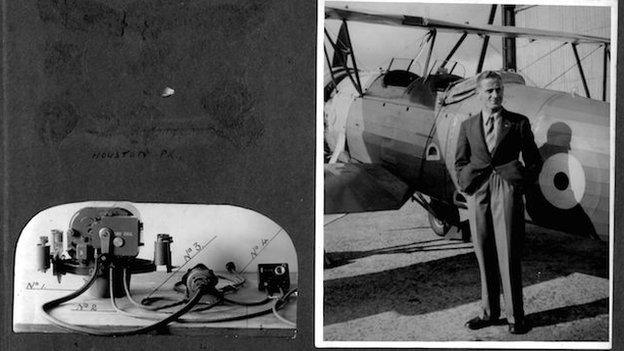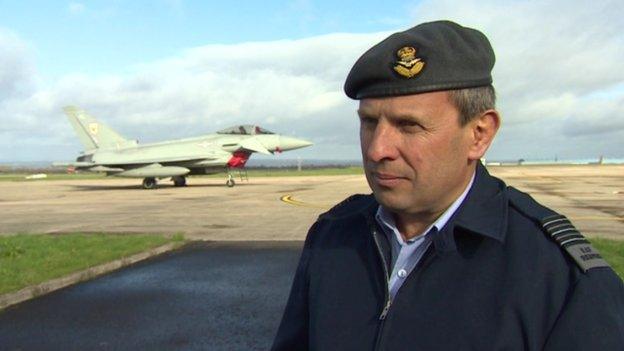Rare RAF Aldergrove film from World War Two found in attic
- Published
The footage shows snapshots of life for servicemen at RAF Aldergrove, County Antrim, shortly after the outbreak of World War Two
Rare footage of Royal Air Force servicemen on duty during the first few months of World War Two has been found in an attic in Northern Ireland.
It features 502 (Ulster) Squadron based at RAF Aldergrove in County Antrim.
The 18-minute film contains images of training exercises and recruits relaxing during their downtime in early WW2. Some of it is rare colour film.
Aviation historians are delighted by the discovery, which one described as a "window into the past".
It is believed the footage was shot by squadron members Sean McNeill and official photographer Herbie Edgar.
With the outbreak of the war in September 1939, Britain and Ireland were bracing themselves for what was to come - either a long struggle against Nazism, or a tightrope walk of neutrality for five years.
'Phoney War'
In County Antrim, 502 Squadron was part of Coastal Command, and was charged with convoy escort, shipping strikes and anti-submarine duties.
The war in the Atlantic started almost on day one, even though the period of the first six months is often called "the Phoney War".
An RAF Anson aircraft from the squadron attacked a U-boat on 24 September, 1939.
They later operated Armstrong Whitworth Whitley, and Handley Page Halifax bombers.
Until recently, aviation historians had no idea of just how much of this period the 502 Squadron photographer, Herbie Edgar, was recording.

Herbie Edgar trained as an RAF photographer during World War Two
"The story begins a few months ago when I was giving a talk at the boat club in Carrickfergus," explains Guy Warner of the Ulster Aviation Society.
"One of the audience came up to see me at the end of the talk and he said 'I've got some very interesting material at home which you might like to come and have a look at'."
The audience member was a son-in law of the former RAF photographer.
Treasure trove
He told Mr Warner that his family had made a discovery as they sorted through Mr Edgar's belongings after his death in 2008.
"The produced photograph albums dating from the 1930s, slides dating from the whole of Shorts history really, a lot of magazines and very different, fascinating bits of memorabilia.
"Included in this though, was a cine film reel," Mr Warner said.
Mr Edgar's daughter and son-in-law told their visitor that they had no idea what was on the reel because they had no projector and no means of viewing it.
The couple asked Mr Warner to take the reel and try to find someone who could help them discover what was on the film.
Guy Warner from the Ulster Aviation Society said the footage opened a "window into the past"
The footage was transferred to a digital format by a BBC cameraman.
It turned out to be a treasure trove of film footage in both colour and black and white from the early period of the war.
"What I thought, when I looked at it first is, this is a real window into the past 70 years ago, and it's in colour," Mr Warner said.
"The thing that struck me most about it, it wasn't formally taken photographs.
"Most of the film seems to me to be fairly informal. So it gives us an insight into what life was like then."
Today's RAF Reservists, based with the 21st Century 502 Squadron at Aldergrove, have been poring over the film as well.

Wing Commander James Armstrong said the footage shows 502 Squadron "at its peak" in preparation for war
The officer in charge, Wing Commander James Armstrong, said it showed the County Antrim base "in its heyday".
"It is a mark in history for 502," Mr Armstrong added.
"You see the comradeship of everyone and the bit of larking around, but also the training and the preparation for war - the painting of the cars, the drills - that is 502 at its peak."
The footage shows snapshots of life for servicemen at RAF Aldergrove, County Antrim, shortly after the outbreak of World War Two
'Considerable casualties'
Mr Warner's fellow Ulster Aviation Society member, Ernie Cromie, said the footage had an important legacy.
"What I find particularly poignant looking at the personnel featured in the film is that, some of them at least, would not have survived the war, because of course 502, like a lot of Coastal Command squadrons suffered considerable casualties during the Battle of the Atlantic," he said.
Some of the footage shows the servicemen swimming, playing cards and pool, and placing beer bottles in their planes.
"I think it's fair to say, in the early stages of the war there probably would have been greater opportunities for lighter moments than later on," Mr Cromie added.
He said the rarity of the footage, and the fact that some of it was in colour, meant it would be of significant value to aviation enthusiasts.
preparingtorecordrnseacattrialsin1965.jpg)
Herbie Edgar later became company chief photographer for the Belfast aviation firm, Shorts
"To aircraft modellers for example, this is the sort of thing that they really love to see because, while records exist indicating how aircraft would have been marked and painted back in those times, quite often questions of this kind can really only be resolved of the basis of either photographs, or in this case, footage.
"So, in that sense it was absolutely marvellous when this particular piece of film came to light," Mr Cromie said.
Medal
Herbie Edgar stayed on as squadron photographer for the rest of the war, and later served in France, Belgium and Holland.
He was awarded the British Empire Medal for rescuing a pilot from the blazing wreckage of his craft.
After the war, he became the company chief photographer for the Belfast aviation firm, Shorts, before retiring in 1981.
Despite the best efforts of its members, the Ulster Aviation Society has been unable to discover the identity of anyone in the 18 minutes of footage.
502 Squadron members went on to destroy six U-boats and a number of enemy merchant vessels in several theatres of war by 1945.
During that time, 174 men were listed as killed or missing.